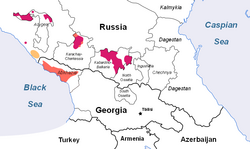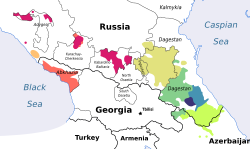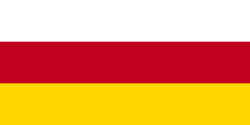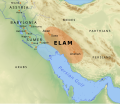Proto-Circassian (or Proto-Adyghe–Kabardian) is the reconstructed common ancestor of the Adyghean and Kabardian languages. The consonant system is reconstructed...
44 KB (856 words) - 11:12, 2 June 2025
Proto-Abazgi language. Wiktionary has a list of reconstructed forms at Appendix:Proto-Northwest Caucasian reconstructions Proto-Circassian language Proto-Abazgi...
11 KB (95 words) - 23:29, 26 April 2025
Northwest Caucasian languages, also called West Caucasian, Abkhazo-Adyghean, Abkhazo-Circassian, Circassic, or sometimes Pontic languages (from Ancient Greek...
16 KB (1,583 words) - 17:12, 1 May 2025
Proto-Chadic Proto-Omotic Proto-Niger–Congo Proto-Bantu Proto-Yoruboid Proto-Basque Proto-Northwest Caucasian Proto-Abazgi Proto-Circassian Proto-Northeast...
5 KB (366 words) - 04:26, 30 March 2025
the Northwest Caucasian language family, spoken by the Circassian people. There are two main variants of the Circassian language, defined by their literary...
34 KB (1,614 words) - 02:41, 25 May 2025
Circassians in diaspora in over 50 countries. The two Circassian languages—western Adyghe and eastern Kabardian—are natively spoken by the Circassian...
146 KB (13,396 words) - 11:32, 21 June 2025
Abkhaz languages. Wiktionary has a list of reconstructed forms at Appendix:Proto-Northwest Caucasian reconstructions Proto-Circassian language Proto-Northwest...
9 KB (123 words) - 21:30, 19 January 2025
/ˌɑːdɪˈɡeɪ/; also known as West Circassian) is a Northwest Caucasian language spoken by the western subgroups of Circassians. It is spoken mainly in Russia...
108 KB (2,908 words) - 19:00, 23 June 2025
Ubykh is an extinct Northwest Caucasian language once spoken by the Ubykh people, an ethnic group of Circassian nation who originally inhabited the eastern...
45 KB (4,610 words) - 18:15, 20 May 2025
and Caucasian languages (such as Circassian, Abkhaz, Nakh-Dagestanian languages etc) now surrounded by Russian. Many creole languages have also arisen...
15 KB (1,562 words) - 07:41, 3 June 2025
Northwest Caucasian (Circassian) family and the extinct Hattic language of central Anatolia. See the article on Northwest Caucasian languages for details. Alarodian...
22 KB (1,729 words) - 23:42, 12 June 2025
Indo-European languages, based on the assumption that parts of the Proto-Indo-Europeans' original belief systems survived in the daughter traditions. The Proto-Indo-European...
141 KB (17,194 words) - 08:54, 23 June 2025
of the Northwest Caucasian family (also called Pontic, Abkhaz–Adyghe, Circassian, or West Caucasian) and the Northeast Caucasian family (also called Nakh–Dagestanian...
9 KB (719 words) - 21:54, 24 November 2024
similar time in the Bronze Age, potentially as a proto-version of the later Circassian and Abkhaz language. The Cimmerians a nomadic Indo-European people...
120 KB (14,568 words) - 13:10, 25 May 2025
Turkic languages such as Uzbek, Azerbaijani, Uyghur, and Kazakh, as well as languages of the Caucasus such as Western and Eastern Circassian languages and...
39 KB (3,171 words) - 01:22, 15 April 2025
Ethnicities in Iran (redirect from Languages and ethnicities in Iran)
Iranian Assyrians, Iranian Jews, Iranian Armenians, Iranian Georgians, Circassians and Mandaeans. In addition to its ethnic diversity, Iranian society is...
70 KB (7,719 words) - 19:16, 22 June 2025
Abzakh dialect (redirect from Abzakh language)
diaspora outside Republic of Adygea alongside Shapsugs. Historically, Proto-Circassian had 6 distinct consonants: d͡ʒ ⟨дж⟩ t͡ʃ ⟨ч⟩ t͡ʃʼ ⟨кӏ⟩ ɡʲ ⟨гь⟩ kʲ ⟨кь⟩...
20 KB (995 words) - 11:41, 31 March 2025
Nart saga (redirect from Circassian folklore)
that the Proto-Indo-Europeans were similarly divided into three castes—warriors, priests, and commoners. The Northwest Caucasian (Circassian, Abkhaz-Abasin...
21 KB (1,909 words) - 13:45, 3 June 2025
non-Pama-Nyungan languages, that a Proto-Australian could be reconstructed from which all known Australian languages descend. This Proto-Australian language, they...
70 KB (6,581 words) - 02:34, 24 June 2025
The Proto-Elamite script is an early Bronze Age writing system briefly in use before the introduction of Elamite cuneiform. There are many similarities...
24 KB (3,055 words) - 19:40, 6 June 2025
are possible indications that proto-Northwest Caucasian, could have divided firstly into proto-Circassian and to proto-Ubykh-Abkhaz; Ubykh then being...
76 KB (5,967 words) - 23:11, 8 June 2025
phylum would also include three extinct languages: Hattic, connected by some linguists to the Northwest (Circassian) family, and Hurrian and Urartian, connected...
3 KB (225 words) - 04:16, 16 June 2025
a list of lists of languages. SIL International's Ethnologue: Languages of the World lists over 7,100 spoken and signed languages. The International Organization...
4 KB (485 words) - 17:14, 29 May 2025
Ergative–absolutive alignment (redirect from Ergative language)
specifically used SOV order, but Circassian allows any order. In contrast, Japanese is a nominative–accusative language: In this language, the argument of the intransitive...
48 KB (4,587 words) - 23:03, 8 June 2025
Digor people (category Articles with Russian-language sources (ru))
dig- with the Circassian endonym A-dyg-e, where the suffix -or could be a mark of plurality as found in many contemporary Caucasian languages. This point...
8 KB (628 words) - 08:05, 9 June 2025
The Proto-Elamite period, also known as Susa III, is a chronological era in the ancient history of the area of Elam, dating from c. 3100 BC to 2700 BC...
11 KB (1,286 words) - 23:57, 21 May 2025
Caucasus (category CS1 German-language sources (de))
Colarusso, pp. 158–168 (Circassian Saga 34: How Pataraz Freed Bearded Nasran, Who Was Chained to the High Mountain), 168–169 (Circassian Saga 35: Bound Nasran);...
55 KB (5,621 words) - 04:31, 25 June 2025
Elam (category Articles containing Hebrew-language text)
the Elamites were ‘Proto-Lurs’ — that is, ancestors of the inhabitants of modern-day Lurestan in western Iran. The Elamite language endonym of Elam as...
92 KB (9,940 words) - 19:21, 17 June 2025
Avars (Caucasus) (category CS1 Russian-language sources (ru))
According to reconstructions, this word descends from *ʔωar in the proto-Avarian language ("ʔ" represents a glottal stop). In modern Avarian, three words...
33 KB (3,459 words) - 03:04, 4 June 2025
Sarmatians (category CS1 German-language sources (de))
civilization. Others assimilated with the proto-Circassian Meot people, and may have influenced the Circassian language. Some Sarmatians were absorbed by the...
84 KB (8,979 words) - 18:30, 18 June 2025


















